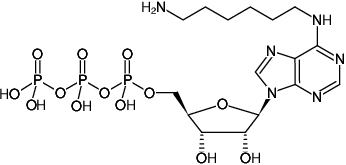No login/account required.
Your Basket/Online Quote
Items: 0 (0,00 €)
» Search & Order
» Sign in / Register
Your Basket/Online Quote
Items: 0 (0,00 €)
» Search & Order
» Sign in / Register
N6-(6-Aminohexyl)-adenosine-5'-triphosphate, Sodium salt
| Cat. No. | Amount | Price (EUR) | Buy / Note |
|---|---|---|---|
| NU-805S | 50 μl (10 mM) | 150,10 | Add to Basket/Quote Add to Notepad |
| NU-805L | 5 x 50 μl (10 mM) | 439,50 | Add to Basket/Quote Add to Notepad |

For general laboratory use.
Shipping: shipped on gel packs
Storage Conditions: store at -20 °C
Short term exposure (up to 1 week cumulative) to ambient temperature possible.
Shelf Life: 12 months after date of delivery
Molecular Formula: C16H29N6O13P3 (free acid)
Molecular Weight: 606.36 g/mol (free acid)
Exact Mass: 606.10 g/mol (free acid)
CAS#: 53602-93-0
Purity: ≥ 95 % (HPLC)
Form: solution in water
Color: colorless to slightly yellow
Concentration: 10 mM - 11 mM
pH: 7.5 ±0.5
Spectroscopic Properties: λmax 266 nm, ε 16.2 L mmol-1 cm-1 (Tris-HCl pH 7.5)
Applications:
Agonistic ligand, mainly for nucleoside receptor A1
Nucleoside-triphosphates can be converted by different membrane-bound phosphatases into nucleosides acting as nucleoside receptor ligands. In some cases nucleoside phosphates act also directly on nucleoside receptors.
Specific Ligands:
Myosin V[1]
BIOZ Product Citations:
Selected References:
[1] Komori et al. (2008) Measurement system for simultaneous observation of myosin V chemical and mechanical events. BioSystems 93:48.
[2] Williamson et al. (2009) Novel adenosine derived inhibitors of 70 kDa Heat Shock Protein, discovered through structure based design. J. Med. Chem. 52:1510.
[3] Teramoto et al. (2000) In vitro selection of a ligase ribozyme carrying alkylamino groups in the side chains. Bioconjugate Chem. 11:744.
[4] Folsom et al. (1989) Detection of DNA targets with biotinylated and fluoresceinated RNA probes. Effect of the extent of derivatization on detection sensitivy. Analytic. Biochem. 182:309.
Sirci et al. (2012) Ligand-, structure- and pharmacophore-based molecular fingerprints: a case study on adenosine A1, A2A, A2B, and A3 receptor antagonists. J. Comput. Aided Mol. Des. 26:1247.
Volonte et al. (2009) Membrane components and purinergic signalling: the purinome, a complex interplay among ligands, degrading enzymes, receptors and transporters. FEBS J. 276:318.
Yegutkin (2008) Nucleotide and nucleoside converting enzymes: Important modulators of purinergic signalling cascade. Biochim. Biophys. Acta 1783:673.
Joshi et al. (2005) Purine derivatives as ligands for A3 adenosine receptors. Current Topics in Medicinal Chemistry 5:1275.
Hess (2001) Recent advantages in adenosine receptor antagonist research. Expert Opin. Ther. Patents 11 (10):1533.
Jacobson (2001) Probing adenosine and P2 receptors: design of novel purines and nonpurines as selective ligands. Drug Development Res. 52:178.
Jacobson et al. (2001) Ribose modified nucleosides and nucleotides as ligands for purine receptors. Nucleosides, Nucleotides & Nucleic Acids 20 (4):333.
Ito et al. (1998) Modified nucleic acid for systematic evolution of RNA ligands by exponential enrichment. J. Bioact. Compat. Pol. 13 (2):114.
Trayer (1974) Affinity chromatography of some adenosine phosphate-requiring systems. Biochem. Soc. T. 2 (6):1302.
Van Galen et al. (1994) A binding site model and structure-activity relationships for rat A3 adenosine receptor. Molecular Pharmacology 45:1101.
Trayer et al. (1974) Preparation of adenosine nucleotide derivatives suitable for affinity chromatography. Biochem. J. 139 (3):609.